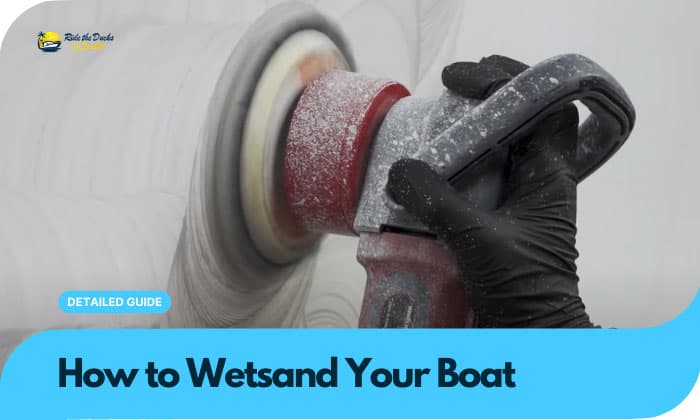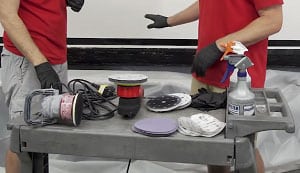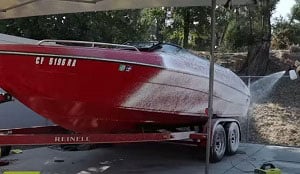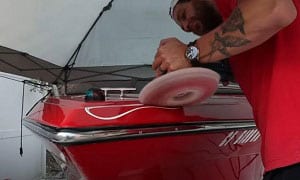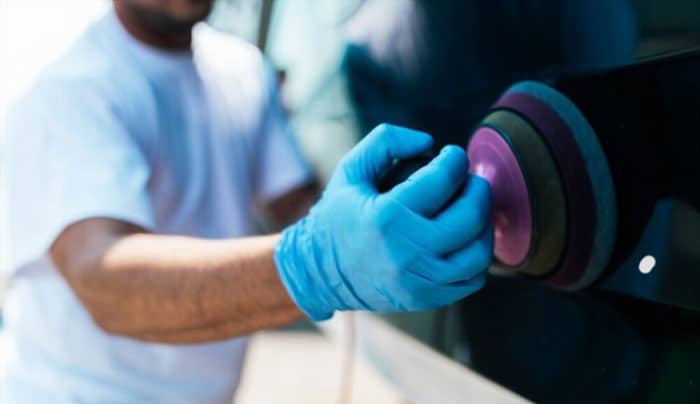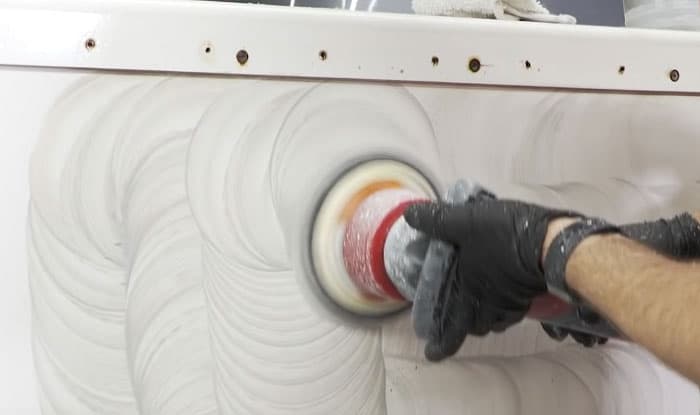Boat owners worth their salt want their watercraft to look sparkling clean, but do you know how to wetsand your boat? After all, I’m sure you’d want to restore your boat to its former glory by eliminating the hazy stains from oxidation.
Looking at various wet sanding boat before and after pictures is enough motivation to do so for our respective watercraft. Do not fret if you are clueless about how to wet sand a fiberglass boat or any marine vessel. We will show you how.
Table of Contents
Steps to Wetsand Your Boat
What to prepare
- 1000-grit wet sanding paper (or you could start with 600-grit)
- Boat wet sanding kit (if you have an orbital sander) or a sanding block
- Store-bought boat cleaner
- Alternatively, you can prepare a homemade cleaning solution by combining 1 cup of water with ¼ cup of baking soda, white vinegar, and a bit of Dawn soap.
- Masking tape
- Wax or polish
- Water
- Personal protective equipment (i.e., mask, goggles, and gloves)
Step 1: Prepare the boat’s surface
Wear your mask, goggles, and gloves because wet sanding gelcoat with orbital sander can be messy. Even if you do it by hand, sanded particles can irritate the eyes or cause respiratory problems.
Use masking tape to cover areas you do not want to smoothen. Then clean the boat with either the store-bought cleaner or homemade soap solution to remove as much debris and particulates as possible. Be thorough; otherwise, you might end up with a bigger problem if a tiny object scratches gelcoat.
Rinse the boat and ensure a more or less “smooth” and clean surface. The water will also act as a lubricant to make the sanding easier.
Step 2: Sand the boat’s surface
When it comes to fixing oxidized gelcoat boats, the most common choice is 1000 grit. That said, you can also pick a 2000 – or 3000-grit sandpaper for gelcoat if the oxidation is minimal. Alternatively, you can start with 600-grit sandpaper to wet sand a boat with heavy oxidation.
Pro Tip: If uncertain, start with coarse sandpaper (i.e., 600-grit) and end with ultra-fine sandpaper (i.e., 3000-grit). Try sanding an inconspicuous area of the boat first to spot-test.
The best wet sanding techniques always involve an orbital sander. To wet sand your boat with this device, observe the following.
- Move the orbital sander horizontally from left to right, or vice versa, moving from the boat’s top to the bottom surfaces. Do this in small sections.
- Wet sand the same section vertically, moving from right to left (or left to right).
- Repeat these steps until you are satisfied with the results.
Wet sanding gelcoat by hand follows the same steps in orbital sanding. Avoid circular motions. Instead, sand the surface vertically and horizontally in a crosshatch pattern with even and long strokes.
Pro Tip: Continue lubricating the boat’s surface with water to prevent sanded debris from scratching the surface. Replace sandpaper as frequently as possible.
Step 3: Buff the boat’s surface
Polishing your boat’s surface is like having a new gelcoat – sparkling, showroom shine. Moreover, it allows you to improve the quality of the finish of wet sanding.
Apply store-bought boat wax or polish on a foam pad. You might want to check the manufacturer’s instructions for application.
You can use an orbital polisher using the same crosshatch pattern described in Step 2. Alternatively, you can buff the surface by hand.
Why Do I Need to Wet Sand My Boat?
Wet sanding your boat is ideal in the following instances.
- Removing heavy oxidation in gel coat surfaces, restoring them to a brand-new-like look
- Applying a fresh layer of marine gel coat
- Applying a fresh coat of paint
- Fix a poorly-executed boat paint job
- Minimize dust production during boat bottom painting
- Negate the “orange peel” effect on new boats
Wet sanding is less abrasive than dry sanding. It allows you to retain your boat’s natural beauty without creating deep cuts into its hull and other surfaces.
Tips to Wetsand Other Boats
The following tricks should help you improve your wet sanding skills on different boat types.
- Fiberglass boats – Although we already described how to wet sand a fiberglass boat, you can improve your technique by using 1000- to 1500-grit sandpaper. You can also wrap a wet sponge with sandpaper, allowing the sponge to lubricate the surface as you sand continuously.
- Wooden boats – Wooden boats need coarse sandpaper (i.e., 320-grit) dipped in water. Wet sanding requires moving the sandpaper along the wood grain.
- Boat hulls – Sanding boat hull sections require inverting the watercraft (turning it upside down) to ensure full access to the hull. Boaters might also want to apply masking tape on boat sections that do not need sanding. Ideally, the tape should be along the boat’s waterline.
FAQs
What grit should be using?
Nine of ten (90%) boat detailers use 1000-grit sandpaper for sanding boat surfaces. However, you might want to start with 600-grit for heavy oxidation and move to finer grit sandpaper (i.e., 1000 or 3000) for a more impeccable finish.
Which will I need to use after wet sanding for successful refinishing?
Sanding only smoothens your boat’s surface. Hence, you might want to apply wax or polish to give it a mirror-like, showroom-shine finish. Buffing the surface will make your boat look brand-new.
The price to wetsand my boat
DIY-style wet sanding should cost about $50 to $100. However, the expenses can go up with boat size.
You can also reduce the cost by improvising the materials or tools. For instance, you only need to buy sandpaper if you already have a polishing machine.
On the other hand, relying on professionals to get oxidation off your boat can cost you $10 to $125 per foot. Hence, you’ll need to pay pros $200 to $2,500 for wet sanding a 20-foot boat.
You can also search for the best “boat detailing near me” and inquire about their services.
Conclusion
We hope our guide on how to wetsand your boat helps you feel more confident restoring your watercraft’s showroom finish. The procedure only involves three easy steps, starting with surface preparation and ending with surface polishing.
Keeping your boat looking brand new is easy with these steps, allowing you to showcase your watercraft anywhere you pilot it. Of course, you can always hire a professional to wet sand your boat. But with this guide, you will never have to.

Ten years of enjoying countless trips on boats never made me love them any less! So I am here to put all those experiences into good use for other boaters who want to have a safe and fun trip with their friends and families.

